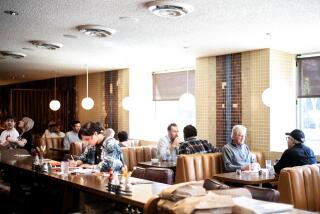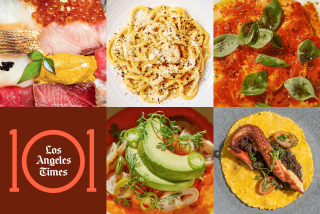South El Monte eatery has oodles of noodles, but few diners
Eric Lam straps on a brown apron early one morning and lugs cardboard boxes filled with beef bones to a large metal pot sitting on a stove, setting in motion the long process that concludes with the next day’s supply of Vietnamese pho noodle soup.
The 22-year-old pulls out white buckets from a walk-in refrigerator, revealing a clear amber broth. This is today’s soup.
When he opened his South El Monte restaurant a year ago, Lam dreamed he would be so busy he would collapse from fatigue after a hard day’s work. But it hasn’t turned out that way.
Many days, he faces long stretches without a single customer. To fill that time, he cuts meat and vegetables, double checks his supplies, blends shrimp paste or does paperwork. He answers annoying calls from telemarketers asking him to invest in “gas and oil” or telling him that he just won a romantic cruise for two.
Lam struggles to break even, though his soups have won praise from bloggers, contributors to the food blog Yelp and food critics.
“This soup is just, it’s just so intense, you know?” said James Jung, a 37-year-old teacher who came from Northridge with his father to Lam’s Pho Minh.
One reason for Lam’s lack of business becomes apparent when you walk outside his restaurant. Pho Minh is one of 10 noodle houses that dot an otherwise unremarkable span of Garvey Avenue, making it the pho capital of Los Angeles County.
Lam ticks off the names of his competition: Pho Hong Long, Pho Huynh, Pho Hien, Pho Hien Mai, Pho Hue, My Hanh, Pho Huong, Pho Kim V and Pho Filet. “Whoa,” he said. “That’s a lot of pho.”
When Lam graduated from high school, his career plans had less to do with cooking soup, and more with building hard drives as a computer engineer. About two years ago, Lam dropped out of San Jose State to work full-time. His parents, refugees from Vietnam, were upset.
“I felt like I committed murder,” Lam said. “I felt like I killed my dad’s dreams. They said, ‘What did I do wrong?’ But it’s nothing they did wrong. It just wasn’t my cup of tea.”
After one year, he quit his $15-an-hour computer technician job in Northern California. He wanted to be a chef.
Lam had grown up with pho, which is generally made by simmering beef bones for more than 10 hours if not overnight, along with Vietnamese cinnamon, charred ginger, cloves, star anise and other spices. The broth is poured on rice noodles and ingredients such as thinly cut meat right before it is served. Pho (pronounced fuh), generally costs $5-$6 a bowl on Garvey Avenue and is eaten for breakfast, lunch or dinner.
Lam’s father, Thanh, 51, heard that Pho Minh was on the market. The space has a few rows of tables, a good luck shrine and a colorful mural in back with an image of Saigon’s Central Square. The cities nearby seemed to promise a steady stream of customers. South El Monte, along with neighboring El Monte and Rosemead, has seen an influx of working-class Vietnamese and Chinese Vietnamese immigrants over the last decade. Buddhist temples have sprouted in neighborhoods.
Lam and his father negotiated with the owners, one of whom was also the chef. They agreed to pay $100,000. Lam’s father gave him $75,000, the remaining $25,000 came from Lam’s savings.
When the Lams bought the noodle house, they also got the restaurant’s pho recipe. Though Eric Lam preferred the recipe that his mother Mai, 52, taught him, he spent about a month observing the chef. The older man’s friends would stroll into the kitchen to give him a hearty hug, often as a cigarette dangled between his fingers. Sometimes, the chef and the other owner would close shop early to gamble at casinos.
When the chef left for good, so did a lot of the customers.
“Actually, I think like 50% of the customers he had were his friends,” Lam said.
American born with a limited grasp of Vietnamese, Lam had a hard time communicating with immigrants. But he talked a lot to those who spoke English.
“We have some really good conversations. I like him a lot,” said Andre Pare, 48, an El Monte resident. Pare said he could sense Lam’s anxiety.
“He has a healthy concern,” Pare said. “If customers aren’t coming in, I hope he doesn’t blame his pho.”
A few months after the opening last April, the pressure was beginning to get to Lam, particularly during those lonely stretches between customers.
“I want to show my parents that I can be successful. It was a chance to show my parents that I really wanted to make something of myself,” Lam said on a recent Wednesday as he dug into a steaming bowl of pho.
Almost two hours had gone by without a customer.
Months after he had opened, Lam checked out the competition, and found his was not the only pho restaurant struggling on Garvey Avenue.
One had opened across the street him in a gleaming, new shopping plaza. Lam went there for lunch. Pho Kim V was very nice, with glossy tables, mahogany chairs and oil paintings. But Lam was the only diner.
Through the local pho customer grapevine, Lam heard that the owner, had overspent on the restaurant. Phong Tran said he paid about $400,000 to buy the space and renovate it.
“I think I’m going to lose it,” Tran, 62, said with a sad smile recently. “I spend too much money, and I have no customers.”
A week ago, just seven months after he opened, Tran closed his restaurant.
Lam learned that as his competitors struggled to stay afloat, they became more desperate. Some gave out cards, offering a free bowl of pho for every 10 bowls ordered. As the months wore on and the economy continued its decline, things got worse for Lam. In the mini-mall where Pho Minh was located, several businesses, including a hair salon, saw a decline in customers.
“And a lot of times our customers are people who came to the salon next door or to one of the other stores in the center,” he said.
Lam’s restaurant was also virtually hidden in a nook of the mini-mall. He later discovered that at least four restaurants in about as many years had opened and closed in the same space -- none surviving longer than a year and a half.
Then, in December, Lam caught a break. Jonathan Gold, a Pulitzer Prize-winning restaurant reviewer for L.A. Weekly, proclaimed Garvey Avenue “ground zero” for the pho cult.
He praised several of the eateries, but reserved his raves for Lam.
“Exactly one of them is found to be divine,” he wrote. “Is Pho Minh the equivalent of Bob’s doughnuts, Mozza’s pizza or Philippe’s French Dip? I submit that it is.”
The Saturday after the article, Lam’s restaurant was nearly packed. Some customers suggested to Lam that he should relocate downtown or to the Westside, where there would be less competition.
“About 75% of the people I saw that first day asked me if I saw the article,” Lam said. “It built up my ego a little. I thought, ‘They will come now.’ ”
Last month, Lam found out that the former chef who sold him the restaurant was hired just a block away as a cook at Pho Huynh, one of the more popular spots on Garvey Avenue.
It grated on Lam, but he remained undaunted. He’s talking about expanding the menu beyond soup and the few rice dishes he offers. On hot days, the hunger for steaming bowls of pho seems to subside, he said. He’s talking about having banners made to advertise the restaurant. He’s convinced business will pick up when the recession ends -- if he can hang in that long.
“I want to take care of my parents. When I turn successful, I’d rather my parents not work for anyone,” he said, as he prepares to mark the restaurant’s first anniversary.
Though Lam still has good days, four months after Gold’s review, his restaurant is almost never packed with customers, not even on weekends.
On that recent Wednesday, at about 6:20 p.m., Pho Minh is empty except for a single customer. A woman sits in a booth eating a bowl of pho. Lam’s mother is in the kitchen. Two other employees had left for the day. The woman pays for her meal and leaves. Lam and his mother clean the tables, straighten chairs and wash pots in the kitchen.
Between 8 and 11 a.m., Lam had served just one customer. There were never more than three people in the restaurant at any point during the lunch hour. The evening seemed a mirror image of the morning.
Lam usually opens at 8 a.m. and closes at 7 p.m. weekdays. He doubts another customer will show up tonight, and a half hour early, he turns off the neon lights flashing from the store front. He pulls a sliding metal grate and closes the restaurant. At home, he takes a shower and sits down in front of his desk to count the day’s receipts. But Lam already knew what kind of a day this one was. Only about 20 diners showed up over more than 10 hours of work.
“Today was a pretty bad day,” he said.
--
More to Read
Eat your way across L.A.
Get our weekly Tasting Notes newsletter for reviews, news and more.
You may occasionally receive promotional content from the Los Angeles Times.







